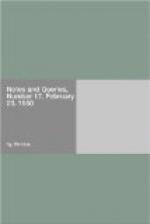Query I.—Is there any historical record of the first discovery of Mauritius and Bourbon by the Portuguese? These islands bore the name of Mascarenhas as early as 1598, when they were so indicated on one of the De Bry’s maps. Subsequent compilers state that they were thus named after their Portuguese discoverer, but I have not succeeded in finding any notice of them in the histories of Portuguese expeditions to the East Indies which I have consulted. The only appartently authentic indication of their discovery, that I am aware of, is the pillar bearing the name of John III. of Portugal, and dated 1545, which is stated by Leguat, on Du Quesne’s authority, to have been found in Bourbon by Flacour, when he took possession of the island in 1653.
Query II.—It appears from Leguat’s New Voyage to the East Indies, London, 1708, pp. 2, 37., that the Marquis Du Quesne, being desirous of sending out a colony from Holland to the Isle of Bourbon in 1689 or 1690, published (probably in Dutch) an account of that Island, with a view of inducing emigrants to go thither. I should be greatly obliged if any of your readers can tell me the title, date, and place of publication of this book, and where a copy of it is to be seen or procured.
Query III.—Are there in existence any original oil-paintings of the Dodo by Savery or any other artist, besides the five described in the Dodo and its Kindred—viz., the one at the Hague, at Berlin, at Vienna, at the British Museum, and at Oxford? And are there any original engravings of this bird, besides that in De Bry, in Clusius, in Van den Broecke, in Herbert, in Bontekoc, and in Bontius, of all which I have published fac-similes?
Query IV.—Are there any original authors who mention the Dodo as a living bird, besides Van Neck, Clusius, Heemskerk, Willem van West-Zanen, Matelief, Van der Hagen, Verhuffen, Van den Broecke, Bontekoe, Herbert, Cauche, Lestrange, and Benjamin Harry? Or any authority for the Solitaire of Rodriguez besides Leguat and D’Heguerty; or for the Dodo-like birds of Bourbon besides Castelton, Carre Sieur D.B., and Billiard?
Query V—In Rees’ Cyclopaeia, article BOURBON, we are told that in that island there is “a kind of large bat, denominated l’Oiseau bleu, which are skinned and eaten as a great delicacy.” Where did the compiler of the article pick up this statement?
Query VI.—Is there in existence any figure, published or unpublished, of the Dodo-like bird which once inhabited the Isle of Bourbon?
Query VII—What is the derivation or meaning of the words Dodaers and Dronte, as applied to the Dodo?
Query VIII.—Sir Hamon Lestrange has recorded that about 1638 he saw a living Dodo exhibited in London. (See Sloane MSS. 1839, v. p. 9. in Brit. Mus.; Wilkin’s ed. of Sir T. Browne’s Works, vol. i. p. 369.; vol. ii, p. 173.; The Dodo and its Kindred, p. 22.) Is there any contemporary notice extant in print or in MS. which confirms this statement? A splendidly bound copy of The Dodo and its Kindred will be given to any one who can answer this query affirmatively.




